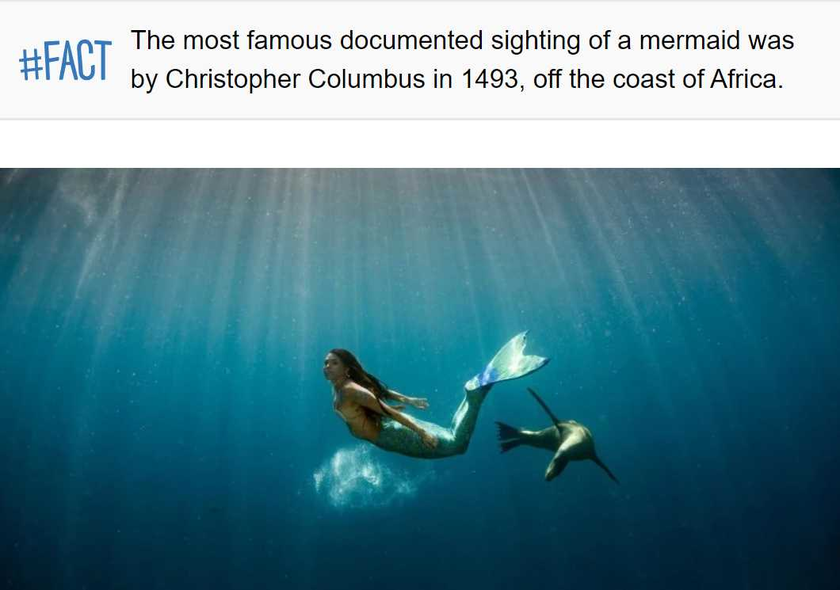Today's post is a little late due to work, but still an interesting topic. So are Mermaids or Merpeople real? Well the following is from thefactsite.com:
"Mermaids, amongst other mystical creatures, play a huge part in popular culture. But are they real, or have they existed in the past?
These creatures of natural beauty that live in the vast oceans have existed in books, texts, and movies for hundreds of years.
Is this because they were once real like dinosaurs, or are they a dreamy illusion that keeps us creative and fuels our imagination?
In this article, we will look at the history of mermaids and determine if they are real.
What are mermaids?
Mermaids are beautiful creatures that consist of a woman’s upper body attached to a beautiful fishtail, and they have appeared in texts for hundreds of years.
The mystical beings have been written about in folklore across Europe, Asia, and Africa.
The legend of mermaids comes from the tales of Merfolk or Merpeople.
The Merfolk were known as water-dwelling humans; mermaids were the name for the female representations of these mystical beings.
Mermen were the male water dwellers.
There is no evidence that they are real, as their representations appear within folklore and mythology, but it is possible that Merfolk existed, however, not how we depict them today.
What defines a mermaid?
Mermaids have been represented in varied ways across the world, from seductive evil creatures of the sea to beautiful, elegant women.
Mermaids are represented in two lights. The first is that they are evil temptresses that lure sailors into the sea with their seductive songs and attractive looks.
The other is that they are women of the sea, like a sea goddess, painted or depicted in a beautiful, elegant manner.
They are shown to be lonely and longing for a man or relationship and to be human.
These depictions of good and evil representations have adapted over time and have been heavily influenced by Germanic Romantic poets and post-romantic painters.
In Greek mythology, they are known as sirens; they were dangerous creatures that tempted sailors.
When was the first documentation of a mermaid?
One of the first documentations of Merfolk comes from a Chinese text written in the fourth century BC.
The Shanhaijing is a classical Chinese text that speaks of mythical beasts, the mountains, and the great geography of the area.
In China, “jiāorén” translates to shark people and is widely written about across medieval texts.
The first appearance of documenting mermen being in the “Record of strange things” text written in the early sixth century CE.
Mermaids appear in Homer’s Odyssey written around 675–725 BCE, where their seductive singing is the killer of men at sea.
This is the first literary text that describes their tempting songs luring sailors in, but in this poem, they manage to escape uninjured.
Mermaids also appear in Assyria around 1,000 BC.
The legend tells of the goddess Atargatis and her transformation into a mermaid after jumping into a lake following feeling ashamed of killing her lover.
She was unable to take the full form of a fish but instead turned into a mermaid because of her beauty.
She is known as the goddess Derketo in Greek mythology.
When was the first sighting of a mermaid?
The most famous documented sighting of an actual mermaid was by Christopher Columbus.
On January 9, 1493, he wrote in his logbook that he had witnessed something magical and never seen before.
Off the coast of Africa, Columbus witnessed three mermaids that elevated above the surface of the sea.
He described them very differently from folklore tales. They weren’t as beautiful and magical but simpler and fish-like with human faces.
It is argued that he was mistaken and actually saw manatees or other sea creatures that could be confused with mermaids if seen from a distance.
Who was The Little Mermaid?
The Little Mermaid is one of history’s most famous mermaid stories, after being produced into a film by Disney in 1989.
The story, originally written by Hans Christian Andersen in 1837, told the tale of a lonely mermaid who was willing to give up her life in the ocean for a real human soul.
The story was one of the first where a tragic tale of a mermaid turned into a story with a happy ending, and it is possibly the most famous mermaid tale across the world.
This was one of the first stories that showed a mermaid to be naïve and innocent, unlike most other depictions of seductive temptresses.
There is a mermaid statue in Copenhagen, Denmark, where the story was written, and it is a popular monument for tourists to visit.
In Conclusion
There is no doubt that the fascination of mermaids will continue to be passed on from generation to generation.
But the question of their existence is unknown and suggests that perhaps there may have been sightings or texts that describe them, but it isn’t solid evidence to suggest they exist.
Another theory is that the Merfolk could have existed across folklore, but just because they lived by the sea does not mean they resembled a half-fish half-human creature.
It could be that the descriptions have been interpreted many years later to depict a mythical creature.
Although they live in folklore tales, there is not strong enough evidence to suggest they exist in real life."
So, do you believe in Mermaids or Merpeople? I personally believe they may exist, but not yet discovered them due to the size and depth of our Oceans. There is a new discovery almost daily from our seas and we still have much to learn.
I have lost a lot of faith with the Medical Community and the Governments over the last several years, but there are a few good things that can raise above the corruption and the pushing of drugs a new approach to heal people. The following is from www.gaia.com and written by Hunter Parsons that does not involve any drug or pushing an ineffective so called vaccine that the drug company is not held accountable in any way but they use sound! The use of sound can regrow bone tissue! Here is the story:
"The future of regenerative medicine could be found within sound healing by regrowing bone cells with sound waves.
The use of sound as a healing modality has an ancient tradition all over the world. The ancient Greeks used sound to cure mental disorders; Australian Aborigines reportedly use the didgeridoo to heal; and Tibetan or Himalayan singing bowls were, and still are, used for spiritual healing ceremonies.
Recently, a study showed an hour-long sound bowl meditation reduced anger, fatigue, anxiety, and ...
Not a fan of a Defense Agency studying Anti-Gravity and other Exotic Tech, but if the commercial world and make this technology cheap that will change our world yet again. The following is about three minute read and from www.gaia.com. The below was written by Hunter Parsons:
"Wormholes, invisibility cloaks, and anti-gravity — it’s not science fiction, it’s just some of the exotic things the U.S. government has been researching.
A massive document dump by the Defense Intelligence Agency shows some of the wild research projects the United States government was, at least, funding through the Advanced Aerospace Threat Identification Program known as AATIP.
And another lesser-known entity called the Advanced Aerospace Weapons System Application Program or AAWSAP
The Defense Intelligence Agency has recently released a large number of documents to different news outlets and individuals who have filed Freedom of Information Act requests.
Of particular interest are some 1,600 pages released to Vice News, which ...
As our technology gets better we are discovering more about the history of mankind and pushing the timeline back further and further. The following article is from www.gaia.com and written by Michael Chary that discusses this new find that changes the historical timeline:
"Over the past decade, there have been a number of archeological revelations pushing back the timeline of human evolution and our ancient ancestors’ various diasporas. Initially, these discoveries elicit some resistance as archeologists bemoan the daunting prospect of rewriting the history books, though once enough evidence is presented to established institutions, a new chronology becomes accepted.
But this really only pertains to the era of human development that predates civilization — the epochs of our past in which we were merely hunter-gatherers and nomads roaming the savannahs. Try challenging the consensus timeline of human civilization and it’s likely you’ll be met with derision and rigidity.
Conversely, someone of an alternative...
Not sure if you have heard of a show on YouTube called "The Why Files". If not you should check it out it is interesting and has some humor with it on different subjects. Last weeks was on a different theory how the Universe works and how main stream Science is attempting to shut it down like is always seems to do if it goes aguest some special interest. Today it is akin to what happened to those who questioned the Earth was the Center of the Universe that main stream so called Science all believed during the Renaissance period, They called any theory that the Earth was not the Center of the Universe misinformation. Does this sound familiar today? People laughed and mocked people like Leonardo da Vinci, Nicolaus Copernicus, Georg Purbach as crack-pots, conspiracy theorists, nut-jobs and they were suppressed and even imprisoned for their radical thoughts and observations. Again it sounds like today in so many ways. In any event this is a good one to ponder and see even if a bad idea ...
Seemingly chaotic systems like the weather and the financial markets are governed by the laws of chaos theory.
We all have heard about chaos theory, but if you have not or have forgotten what chaos theory is well here you go from interestingengineering.com:
"Chaos theory deals with dynamic systems, which are highly sensitive to initial conditions, making it almost impossible to track the resulting unpredictable behavior. Chaos theory seeks to find patterns in systems that appear random, such as weather, fluid turbulence, and the stock market.
Since the smallest of changes can lead to vastly different outcomes, the long-term behavior of chaotic systems is difficult to predict despite their inherently deterministic nature.
As Edward Lorenz, who first proposed what became commonly known as the Butterfly Effect, eloquently said, "Chaos: When the present determines the future, but the approximate present does not approximately determine the future.""
You may have heard the term about chaos theory as a butterfly flaps its wings in Brazil,...
I for one have lost trust in Medical Doctors due to COVID and reflection that they seem to push pills for everything and untested so called vaccines that is using a unproven technology because the Government and the Medical Boards of the State told them to. There are a very few exceptions. Thus they do not address the key problem just prescribe more and more pills to keep you alive an sick longer for them and Big Phama to profit from you. Will AI do any better? Well that depends on what was used for the training of AI. If it also pushes pills and vaccines without question then you have the same problems noted above. However, if the AI Training includes all possible forms of treatment and they zero in on the right issues for the true problem then there is possibilities they would be way better than most of the current Medical Doctors today.
The following is from an article from interestingengineering.com and written by Paul Ratner:
"A new study looks at how accurately AI can diagnose patients. We interview the researcher, who weighs in on AI's role ...




























